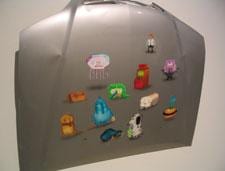Larger Toronto galleries are now officially in summer show mode. The Museum of Contemporary Canadian Art is no exception, opting for a lighter, less conceptually driven exhibition with its current group show Pulp Fiction.
Imported from Museum London the show was curated by Corinna Ghaznavi who maps out a particular branch of drawing that has emerged globally and traces its expressions in Canada. The artists she’s chosen all work in a looser brand of highly illustrative graphics, directly influenced by, and deeply indebted to, comic book art.
On the upside Ghaznavi has done an exceptional job of culling work from across Canada without being tokenistic: queer artist Barry Doupé and The Lions drawing club from Vancouver, Marc Bell from Montreal, Seth Scriver and Shayne Ehman from Toronto, Amy Lockhart, who’s generally been all over the place. And Ghaznavi has certainly identified a palpable, easily recognizable school of artistic expression. However, it’s a little too easily recognizable. So much so, in fact, that I’m not so sure all this work benefits from being exhibited together.
The aesthetic that is forwarded here is very much of the adolescent male stoner variety (think Vice Magazine, circa 2001): blobby forms, grotesque caricature-ish figures, free associative bits of text strewn about the page that riffs on some barely subcultural geek theme (Bell and Peter Thompson devote an entire series of drawings to a silly mockery of The Hobbit). In many ways, Scriver and Ehman’s Asphalt Watches videos are an apt summary of the entire show. They are Flash-animated episodes of a hobo ghost and his hoser pal who hitchhike across a trippy, fictional Canada, encountering all sorts of bizarre creatures on the way. The narrative is rambling and random, full of odd songs and cribbed one-liners, the drawing and animation walking the very fine line of seeming clumsy and naive. They’re initially charming and funny (the “boiled hot dog” rap song will stick in your head the entire day, I guarantee it), but it’s a little like being the only sober person in a room full of pot-heads: The humor wears thin fast and the charm that it was floating on dissipates. There’s not much substance here to begin with, certainly not enough to carry it for the full 40 minute run time.
The lack of substance is not the only thing that’s pervasive here — all of these boys (and they are, except for three out of 14 artists, boys) draw the exact same way: the same clunky mock-naïve style, the same tone, the same cultural references, the same love of absurdity. There were times when I couldn’t tell individual artists apart. And, just as in the Scriver and Ehman videos, the initial cutesy charm begins to pall — it’s certainly incapable of carrying an entire show. This lack of substance begins to grate very, very quickly and the work starts to look more and more like inconsequential doodling.
Amy Lockhart is poorly served by this show, as she gets pulled in its undertow. Usually I find her work wildly imaginative, but when placed in this context, there are too many superficial similarities (especially to the work of Bell) to prevent it from being drowned out. Doupé is the sole survivor here: His At the Heart of A Sparrow, a 25-minute animation doesn’t look like anything else, for a start. And while Doupé navigates the same terrain of dreamy absurdity, there is an insistent tenacity to his narrative that gives his work depth and power; it doesn’t merely sustain your attention, he creates an enrapturing universe.
All told, however, the show is simply negligible. Certainly the fact that this particular comic-book aesthetic is breeding slavish devotees across the country is interesting, and in the hands of a different curator, could have been an interesting show. In assembling group exhibitions, one strives for clarity, focus and cohesion. But what do you do when the work itself lacks clarity and focus? And there is such a thing as too much cohesion; indeed, the assembled work coheres so much that it’s virtually indistinguishable.

 Why you can trust Xtra
Why you can trust Xtra


